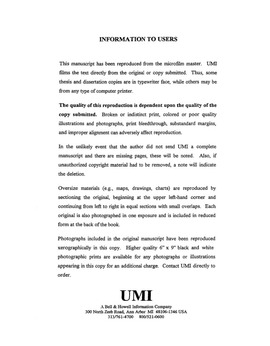| dc.contributor.advisor | Rideout, Roger, | en_US |
| dc.contributor.advisor | Magrath, Jane, | en_US |
| dc.contributor.author | Widen, Dennis C. | en_US |
| dc.date.accessioned | 2013-08-16T12:30:32Z | |
| dc.date.available | 2013-08-16T12:30:32Z | |
| dc.date.issued | 1999 | en_US |
| dc.identifier.uri | https://hdl.handle.net/11244/5812 | |
| dc.description.abstract | Instruction during course was designed and conducted by the researcher. Instructional systems design (ISD) procedures were employed to (1) identify specific instructional goals, (2) develop teaching strategies, and (3) choose instructional technologies to support students' learning. | en_US |
| dc.description.abstract | Descriptive data about students in the sample were collected using a researcher-designed Student Profile Questionnaire. Qualitative data were gathered in a series of three individual interviews conducted during the study. To interpret the data, the researcher used (1) the characteristics of the cognitive field-dependent/independent learning style; (2) the cognitive learning theories of Brunner and Ausubel; (3) a matrix of cognitive music skills by Davidson and Scripps; and (4) Dillon's analytical model to identify the attributes of instructional technologies. The data revealed that the students within these two groups of learners responded in similar ways to the educational technologies used during instruction. Patterns emerged in (1) the kinds of instructional technologies students identified as important in their learning; (2) the kinds of learning skills specific technologies supported; and (3) how the technologies were used in instruction. | en_US |
| dc.description.abstract | Educational technologies have played an important role in college group piano instruction during the past three decades. Among the reported benefits have been increases in students' motivation and persistence in their learning. However, many keyboard educators have posed questions about how using instructional technologies affects student's learning processes. The purpose of the study was to investigate how students with a specific cognitive learning style responded to the instructional technologies used in group piano studies. | en_US |
| dc.description.abstract | The study was conducted during the 1998 spring semester at the University of Oklahoma. The students enrolled in two sections of Level II Group Piano served as the population for the study. Twenty-five (N = 25) students volunteered to participate in the study. The cognitive style of field-dependence/field-independence was chosen for the investigation. Following administration of the Group Embedded Figures Test, four (4) field-dependent and four (4) field-independent learners were selected as the study sample (N = 8). | en_US |
| dc.format.extent | xi, 496 leaves : | en_US |
| dc.subject | Education, Technology of. | en_US |
| dc.subject | Piano Method Group instruction. | en_US |
| dc.subject | Piano Instruction and study. | en_US |
| dc.subject | Education, Music. | en_US |
| dc.title | Field-dependent/independent learner responses to instructional technologies used in college group piano classes. | en_US |
| dc.type | Thesis | en_US |
| dc.thesis.degree | Ph.D. | en_US |
| dc.thesis.degreeDiscipline | School of Music | en_US |
| dc.note | Major Professors: Roger Rideout; Jane Magrath. | en_US |
| dc.note | Source: Dissertation Abstracts International, Volume: 60-05, Section: A, page: 1495. | en_US |
| ou.identifier | (UMI)AAI9930529 | en_US |
| ou.group | Weitzenhoffer Family College of Fine Arts::School of Music | |
